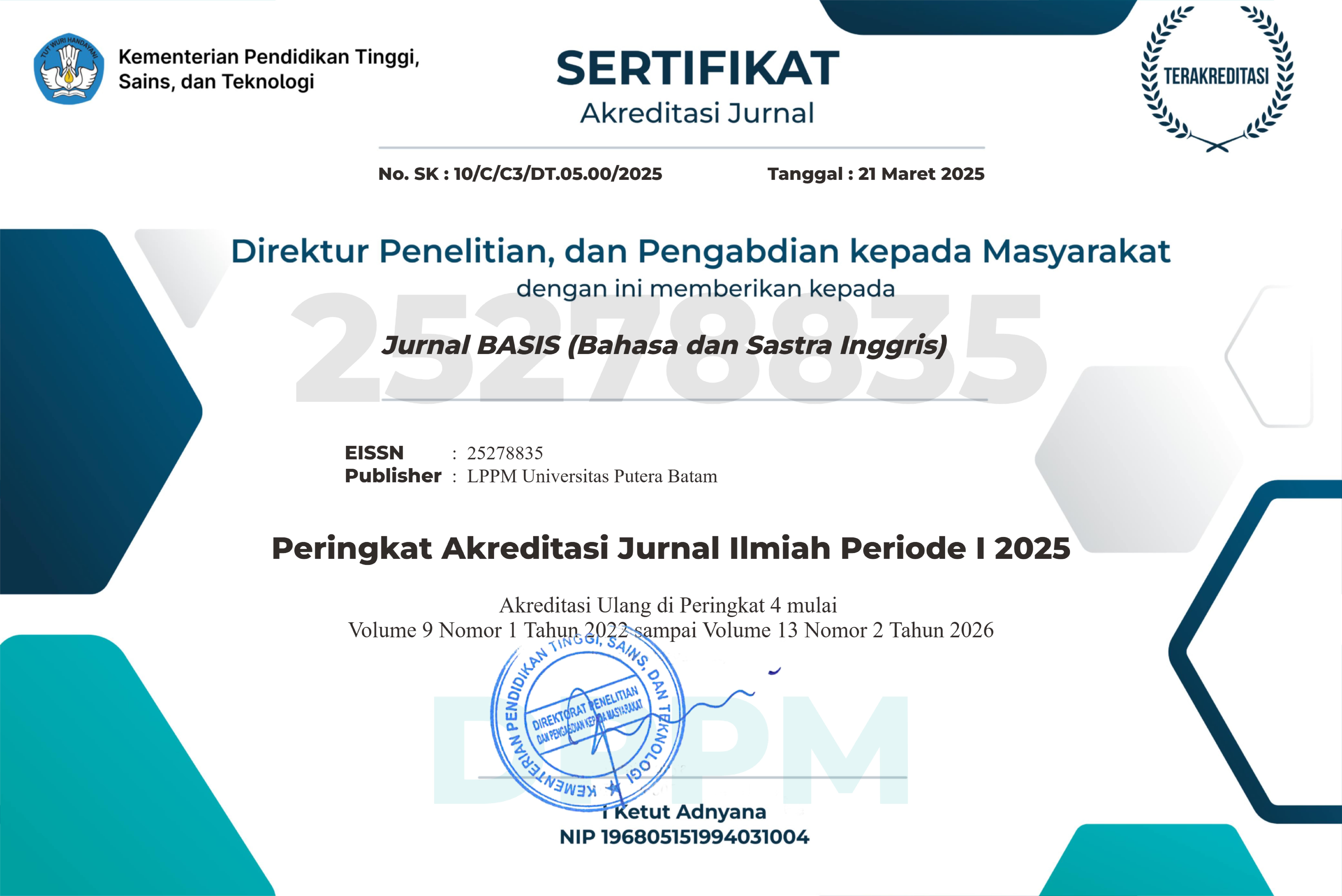THE STUDENTS’ IMPLEMENTATION OF ETIQUETTE IN TABLE MANNERS PROGRAM
DOI:
https://doi.org/10.33884/basisupb.v12i1.9987Keywords:
Implementation ,Etiquette, Table MannersAbstract
This study aims to analyze the implementation of student etiquette in a program that teaches the rules of manners in the context of communal dining. Table etiquette is an essential part of social and professional life, and these skills are expected to enhance students' self-image and interpersonal abilities. The research method involved distributing questionnaires and conducting interviews with 7th-semester students who participated in the program. The findings indicate that the majority of 7th-semester students were able to apply etiquette well, although some challenges were observed in understanding and practicing more complex rules. Factors affecting the success of etiquette implementation include the level of understanding, cultural background, and the influence of instructors. This study recommends the need for a more structured approach and a variety of teaching methods to improve the effectiveness of the Table Manner program for 7th-semester students.
References
De Moura, L., & Bjørner, N. (2009). Satisfiability modulo theories: An appetizer. Lecture Notes in Computer Science (Including Subseries Lecture Notes in Artificial Intelligence and Lecture Notes in Bioinformatics), 5902 LNCS, 23–36. https://doi.org/10.1007/978-3-642-10452-7_3
Djajadiningrat, T., Feijs, L., Hu, J., Rampino, L., & Rodriguez, E. (2012). Design and semantics. DeSForM 2012: Meaning.Matter.Making, April, 18–20. http://nrl.northumbria.ac.uk/9223/%5Cnhttp://desform2012.schoolofdesign.ac.nz/proceedings
Bradshaw, C., Atkinson, S., & Doody, O. (2017). Employing a qualitative description approach in health care research. Global Qualitative Nursing Research, 4, 2333393617742282. https://doi.org/10.1177/2333393617742282
Caelli, K., Ray, L., & Mill, J. (2003). 'Clear as mud': Toward greater clarity in generic qualitative research. International Journal of Qualitative Methods, 2(2), 1–13. https://doi.org/10.1177/160940690300200201
Chafe, R. (2017). An overview of the qualitative descriptive design within nursing research. Journal of Nursing Education and Practice, 7(11), 1–7. https://doi.org/10.5430/jnep.v7n11p1
Colorafi, K. J., & Evans, B. (2016). Qualitative descriptive methods in health science research. HERD: Health Environments Research & Design Journal, 9(4), 16–25. https://doi.org/10.1177/193758671600900404
Creswell, J. W. (2010). Research design: Qualitative, quantitative, and mixed methods approaches (3rd ed.). Sage Publications.
Doyle, L., McCabe, C., & O’Reilly, M. (2016). An overview of the qualitative descriptive design within nursing research. Journal of Nursing Education and Practice, 7(11), 1–7. https://doi.org/10.5430/jnep.v7n11p1
Hallberg, L. R. M. (2013). The characteristics of qualitative descriptive studies. Nursing Research and Practice, 2013, 1–6. https://doi.org/10.1155/2013/578254
Kim, H., Sefcik, J. S., & Bradway, C. (2017). Characteristics of qualitative descriptive studies: A systematic review. Research in Nursing & Health, 40(1), 23–42. https://doi.org/10.1002/nur.21768
Lambert, V. A., & Lambert, C. E. (2012). Qualitative descriptive research: An acceptable design. Pacific Rim International Journal of Nursing Research, 16(4), 255–256.
Lincoln, Y. S., & Guba, E. G. (1985). Naturalistic inquiry. Sage Publications.
Neergaard, M. A., Olesen, F., Andersen, R. S., & Sondergaard, J. (2009). Qualitative description – The poor cousin of health research? BMC Medical Research Methodology, 9, 52. https://doi.org/10.1186/1471-2288-9-52
Ormston, R., Spencer, L., Barnard, M., & Snape, D. (2014). The foundations of qualitative research. In J. Ritchie, J. Lewis, C. McNaughton Nicholls, & R. Ormston (Eds.), Qualitative research practice: A guide for social science students and researchers (2nd ed., pp. 1–25). Sage Publications.
Palinkas, L. A., Horwitz, S. M., Green, C. A., Wisdom, J. P., Duan, N., & Hoagwood, K. (2015). Purposeful sampling for qualitative data collection and analysis in mixed method implementation research. Administration and Policy in Mental Health and Mental Health Services Research, 42(5), 533–544. https://doi.org/10.1007/s10488-013-0528-y
Ritchie, J., Lewis, J., Nicholls, C. M., & Ormston, R. (2014). Qualitative research practice: A guide for social science students and researchers (2nd ed.). Sage Publications.
Sandelowski, M. (2000). Focus on research methods: Whatever happened to qualitative description? Research in Nursing & Health, 23(4), 334–340. https://doi.org/10.1002/1098-240X(200008)23:4<334::AID-NUR9>3.0.CO;2-G
Sandelowski, M. (2010). What's in a name? Qualitative description revisited. Research in Nursing & Health, 33(1), 77–84. https://doi.org/10.1002/nur.20362
Sullivan-Bolyai, S., Bova, C., & Harper, D. (2005). Developing and refining interventions in persons with health disparities: The qualitative descriptive approach. Journal of Nursing Scholarship, 37(1), 77–84. https://doi.org/10.1111/j.1547-5069.2005.00027.x
Sorto, I. M. A., & White, A. (2018). ICOTS10 (2018) Invited Paper Almeda. 10, 1–5.
Stenson, N., & Hornby, A. S. (1996). Oxford Advanced Learner’s Dictionary of Current English. The Modern Language Journal, 80(3), 412. https://doi.org/10.2307/329464
Suryanto, I. W., Astuti, N. M. E. O., & Diarini, I. G. A. A. S. (2020). Efektivitas program pelatihan pengolahan hidangan appetizer and dessert pada siswa SMK Pratama Widhya Mandala. JPPM (Jurnal Pendidikan Dan Pemberdayaan Masyarakat), 7(2), 159–171. https://doi.org/10.21831/jppm.v7i2.32235













 JURNAL BASIS (BAHASA DAN SASTRA INGGRIS)
JURNAL BASIS (BAHASA DAN SASTRA INGGRIS)
